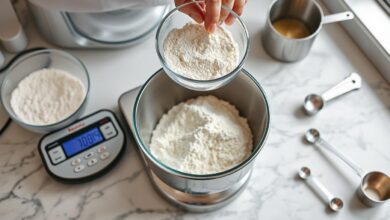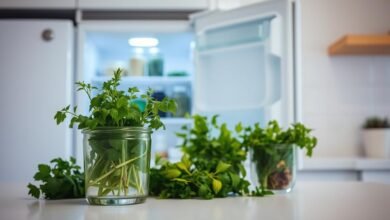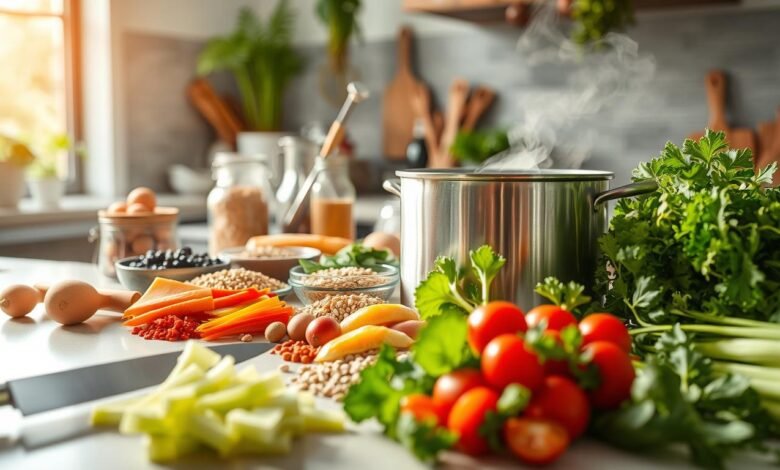
Define Healthy Cooking Techniques — Do you remember how bad it felt when your steamed vegetables got mushy or your chicken lost its juiciness? We’ve all had times in the kitchen when our good intentions didn’t lead to great results.
The secret lies in how you handle ingredients. Simple shifts like quick roasting instead of boiling can unlock vibrant colors and crisp textures in your dishes. These methods preserve essential vitamins while creating satisfying meals that make you excited to eat well.
Your choices at the stove directly impact what your body absorbs. High-heat methods can destroy delicate nutrients, while gentle approaches maintain food’s natural goodness. The right approach balances taste and nourishment – think golden roasted carrots over soggy ones, or perfectly seared fish instead of dried-out fillets.
This guide reveals practical ways to transform your meals through science-backed preparation styles. You’ll discover how to maximize flavor profiles while keeping dishes nutrient-dense. Whether you’re sautéing greens or baking proteins, each technique becomes a tool to nourish your body and delight your taste buds.
Introduction to Healthy Cooking Techniques
Have you ever wondered why some meals leave you feeling energized while others don’t? The answer often lies in how you handle ingredients before they hit the pan. Smart preparation approaches protect vitamins and minerals your body needs, turning ordinary dishes into nutrient powerhouses.
What Are Nutrient-Focused Preparation Styles?
These approaches prioritize keeping food’s natural benefits intact. Instead of drowning vegetables in oil or boiling them to death, methods like quick steaming or roasting maintain texture and vitamins. The World Cancer Research Fund confirms that how you cook directly affects disease risks and nutrient absorption.
The Science Behind Smart Food Handling
Heat and water can be allies or enemies in your kitchen. Water-soluble vitamins like B and C vanish when boiled too long, while quick stir-frying preserves them. Some methods even boost nutrient availability – tomatoes release more lycopene when cooked gently. Your choice of tools and timing determines whether meals nourish or merely fill your stomach.
Using less oil doesn’t mean sacrificing flavor. Herbs, citrus, and spices add zest without empty calories. Remember: every sizzle, steam, and sear either builds up or breaks down what makes ingredients truly good for you.
Understanding the Benefits of Healthy Cooking
Ever notice how some meals leave you satisfied for hours while others create an energy crash? The difference often starts with how you prepare ingredients. Choosing methods that lock in natural goodness transforms ordinary dishes into meals that work harder for your body.
Water-soluble vitamins like C and B complex vanish when boiled too long. Quick methods like steaming or stir-frying keep these fragile nutrients intact. Research shows proper preparation can preserve up to 50% more vitamins in vegetables compared to traditional boiling.
Smart food handling does more than protect what’s already there. Certain techniques actually boost nutrient absorption. For example, lightly cooking tomatoes increases lycopene availability by 25%. You’re not just eating better – you’re absorbing more from every bite.
These approaches naturally reduce reliance on added fats. A study in the Journal of Culinary Science found air-frying uses 70% less oil than deep-frying while maintaining crisp textures. Your diet gains flavor through herbs and citrus instead of empty calories.
The ripple effects go beyond your plate. Consistent use of these methods supports better digestion through preserved fiber and enzymes. Vibrant colors and satisfying crunch make meals visually appealing, helping you stick to nourishing choices long-term.
Popular Healthy Cooking Methods
What if your kitchen routine could deliver crispy textures and bold flavors while keeping meals nourishing? Modern approaches let you achieve both goals effortlessly. These strategies work with your existing ingredients but transform results through smart heat management and timing.
Gentle Heat, Maximum Nutrition
Steaming shines for delicate items like broccoli and fish. The process uses vapor instead of direct water contact, locking in vitamin C and folate. Try bamboo baskets or microwave-safe containers with vents for quick results.
Stir-frying turns weeknight dinners into vibrant feasts. A tablespoon of oil and blistering-hot pan preserve crunch in snap peas while caramelizing surfaces. Pair with lean proteins for balanced meals that stay juicy.
Your microwave isn’t just for reheating. It cooks food rapidly with minimal water, saving up to 40% of heat-sensitive nutrients compared to boiling. Perfect for steaming carrots or softening greens without mushiness.
Dry Heat Done Right
Baking in your oven offers crispy edges without drowning food in oil. Foil packets trap moisture for salmon fillets, while roasted veggies develop natural sweetness. This method works wonders for batch-prepping meals.
Air-frying creates golden textures through circulated heat instead of grease. A University of Illinois study found it reduces fat content by 75% compared to deep-frying. Enjoy crispy sweet potato fries or chicken tenders guilt-free.
| Method | Medium | Oil Needed | Nutrient Retention | Best For |
|---|---|---|---|---|
| Steaming | Vapor | None | High (water-soluble vitamins) | Vegetables, fish |
| Stir-Frying | Pan + high heat | 1-2 tsp | Medium-high | Mixed veggies, lean meats |
| Microwaving | Electromagnetic waves | None | High | Quick veggie prep |
| Baking | Dry oven heat | Optional spray | Medium | Proteins, root veggies |
| Air-Frying | Hot air circulation | Light mist | Medium-high | Crispy textures |
Each approach solves specific kitchen challenges. Steam when preserving color matters most. Reach for the oven when developing caramelized flavors. With these methods, you’ll cook food that satisfies both taste buds and nutritional needs.
Define healthy cooking techniques
Transforming your kitchen routine starts with smart prep strategies. You’ll craft vibrant meals that retain nutrients through intentional steps – no culinary degree required.
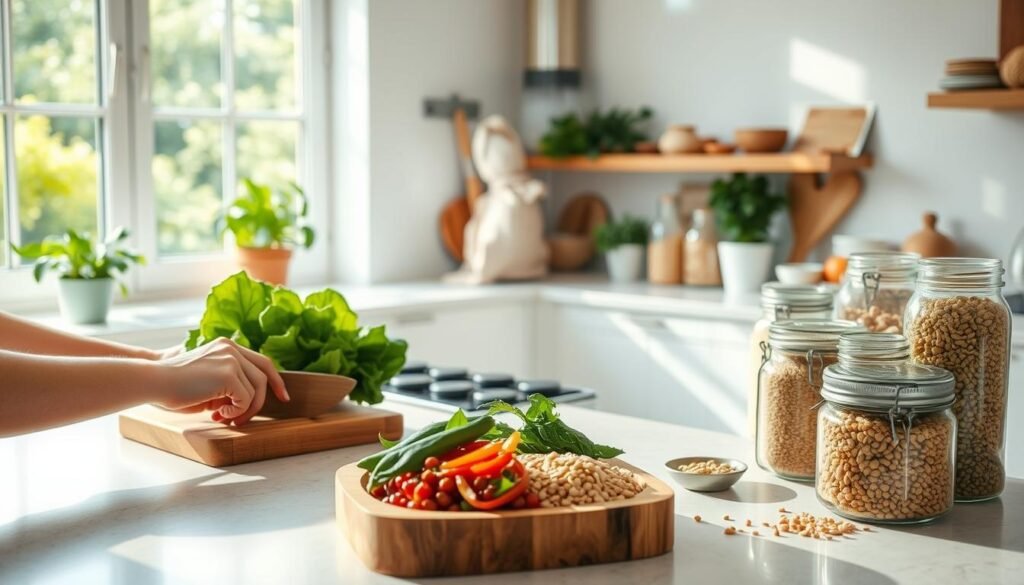
Step-by-Step Guide to Healthier Meal Preparation
Begin by matching your ingredients to the best technique. Leafy greens thrive with quick wilting, while root vegetables need roasting to unlock sweetness. This decision impacts both flavor and vitamin retention.
Prep work matters. Wash produce gently to avoid bruising, then cut uniformly for even cooking. Organize tools before heating pans – rushed moments often lead to overcooked food.
Master temperature control. Lower heat preserves delicate nutrients better than high flames. Steam broccoli for 4 minutes instead of boiling for 10, keeping 30% more vitamin C intact according to USDA research.
Season smartly. Crushed garlic and smoked paprika add depth without salt overload. A squeeze of lemon brightens steamed fish better than butter. These swaps turn simple dishes into healthiest cooking triumphs.
Finally, layer methods for balanced plates. Pair roasted chicken (dry heat) with sautéed kale (quick cook). This systematic approach ensures every bite delivers maximum nourishment and satisfaction.
Selecting the Right Ingredients and Tools
Ever opened your fridge and wondered why some meals sing while others fall flat? Your success starts before you turn on the stove. The brightest vegetables and freshest proteins become your allies when paired with smart preparation.
Choosing Fresh Vegetables, Lean Proteins, and Whole Foods
Start with crisp, colorful produce. Vibrant greens and firm root vegetables retain more vitamins and cook evenly. Look for broccoli with tight florets and carrots without cracks – these signs mean peak freshness.
Lean proteins like chicken breast or salmon fillets need gentle handling. Wrap them in parchment paper when baking to lock in moisture without added fats. This method keeps fish tender and prevents drying out.
Swap processed items for whole foods that work with your kitchen tools. Quinoa cooks faster in a rice cooker than instant noodles boil. Fresh herbs add zing without salt overload.
Mix textures and colors for natural appeal. Combine crunchy snap peas with velvety roasted squash. Alternate between pan-seared chicken and citrus-marinated fish throughout the week. This variety keeps meals exciting and nutrient-dense.
Match your ingredients to their ideal prep style. Delicate spinach wilts quickly in a hot pan, while sturdy sweet potatoes thrive in the oven. Your choices determine whether you preserve nutrients or lose them to heat.
Mastering Temperature Control to Preserve Nutrients
Ever notice how vibrant veggies turn dull when cooked too aggressively? That color fade signals more than visual appeal loss – it’s a warning bell for nutrient destruction. Your stove dial holds the power to protect or plunder your food’s natural benefits.
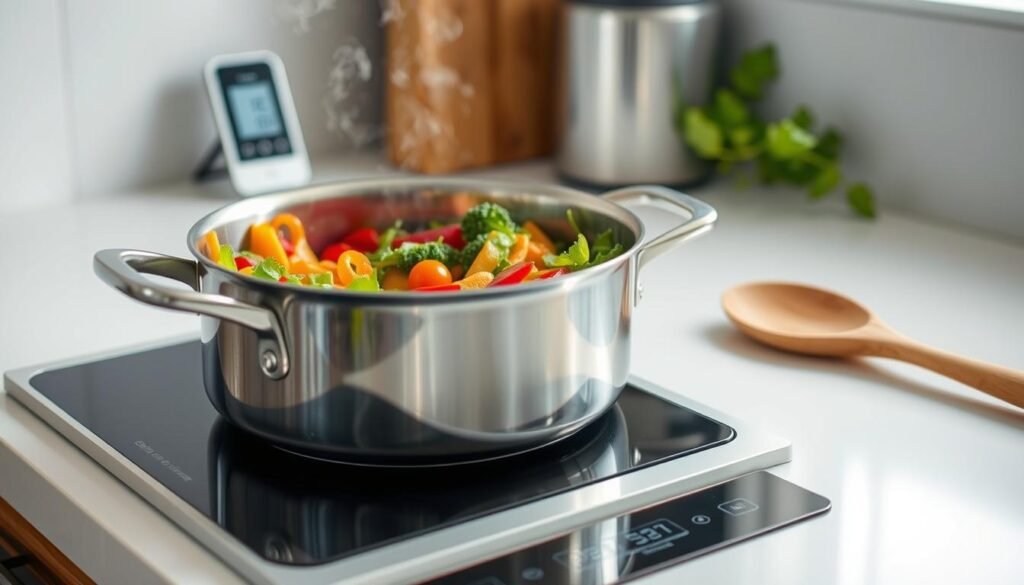
Smart Heat Management for Better Results
Water-soluble vitamins like C and B-complex vanish when exposed to high heat too long. Broccoli loses 40% of its vitamin C when boiled versus 10% when steamed. Keep pans at medium settings to balance speed with nutrient retention.
Starchy foods like potatoes need extra care. Prolonged frying at extreme temperatures creates acrylamide – a compound linked to health risks. Roast at 375°F instead of 425°F to achieve crispness safely.
| Temperature Range | Effect on Nutrients | Best For | Tips |
|---|---|---|---|
| High (400°F+) | Destroys water-soluble vitamins | Quick searing | Limit to 2-3 minutes |
| Medium (300-375°F) | Preserves most vitamins minerals | Roasting, baking | Use timer |
| Low (200-300°F) | Retains delicate nutrients | Slow-cooking greens | Add liquid to prevent burning |
Watch for visual cues to prevent overheating. Oil shouldn’t smoke – that signals dangerous temperatures. Proteins sizzling violently? Lower the flame immediately.
Pair shorter cook times with moderate heat. Sauté greens for 4 minutes instead of 8. You’ll keep their bright color and folate content intact. Your meals become nutrient powerhouses without sacrificing texture.
Enhancing Flavors Naturally with Herbs and Spices
Who says flavor-packed meals need heavy sauces or salt shakers? Your spice rack holds the key to bold tastes that elevate simple dishes. These natural enhancers add complexity without hiding your ingredients’ true character.
Powerful Pairings for Vibrant Dishes
Citrus zest wakes up steamed veggies better than butter. A sprinkle of lemon juice on grilled chicken keeps it moist while adding vitamin C. Try rubbing salmon with orange peel before baking – you’ll get crispy skin and subtle sweetness.
Marinades work double duty. Mix olive oil, crushed garlic, and rosemary for meats. The acid in lime juice tenderizes while herbs infuse flavor. Studies show these blends may reduce harmful compounds when grilling at high temps.
| Method | Key Ingredients | Flavor Impact | Health Benefit |
|---|---|---|---|
| Citrus Zest | Lemon, orange peel | Brightens mild dishes | Boosts vitamin intake |
| Fresh Herbs | Basil, cilantro, thyme | Adds earthy/peppy notes | Provides antioxidants |
| Spice Blends | Cumin, paprika, turmeric | Creates depth | Anti-inflammatory properties |
| Acidic Marinades | Vinegar, yogurt, lime | Tenderizes proteins | Reduces charring risks |
Dried spices pack concentrated punches. Toast cumin seeds briefly to unlock nutty aromas. Blend smoked paprika with oregano for smoky roasted veggies. These combos turn basic ingredients into exciting meals.
Remember: fresh isn’t always better. Dried rosemary stands up to oven heat, while fresh basil shines in cold sauces. Match your herbs and spices to cooking methods for maximum impact.
Creative Meal Ideas with Healthy Cooking Techniques
Transform your weekly menu with smart kitchen strategies that turn simple ingredients into exciting dishes. Imagine juicy chicken bursting with rosemary and lemon, or rainbow veggies caramelized to perfection – all while sticking to your diet goals.
Fire up the grill for smoky flavors without heavy sauces. Marinate lean proteins in citrus and garlic for 30 minutes before grilling. Pair with charred zucchini or bell peppers brushed lightly with olive oil. This method keeps meals low in fat while adding depth through natural charring.
Your oven becomes a flavor amplifier with parchment packets. Wrap salmon fillets with dill and thin lemon slices, then bake at 375°F. The sealed pouch steams fish gently, locking in omega-3s. Try the same approach with chicken thighs and cherry tomatoes for effortless cleanup.
Revolutionize weeknights with your pan. Sear scallops in a screaming-hot skillet for 90 seconds per side – they’ll develop a golden crust while staying tender inside. Toss in snap peas during the last minute for crunch. This cooking approach uses minimal oil but delivers restaurant-worthy textures.
Rotate methods to keep your diet exciting. Air-fry Brussels sprouts on Monday, stir-fry shrimp Wednesday, and grill pineapple chicken Friday. Each technique brings unique benefits, ensuring you cook food that’s as nourishing as it is delicious.
Troubleshooting Common Healthy Cooking Challenges
Struggling with soggy veggies or dry chicken despite your best efforts? Many home chefs face these hurdles when adjusting their kitchen habits. Let’s tackle solutions that keep meals tasty and nutrient-packed.
Mastering Oil Measurement
Use a spray bottle or pastry brush to apply small amounts of oil evenly. This cuts fat content by 50% compared to pouring from bottles. Non-stick pans need just a teaspoon for most recipes – enough to prevent sticking without excess grease.
Watch water levels like a hawk. Steaming broccoli with ¼ cup liquid preserves 30% more vitamins than boiling. For roasted potatoes, toss chunks with a measured teaspoon of oil instead of drenching them.
Spotting Doneness Cues
Your pan tells stories through sounds and smells. Proteins sizzle quietly when nearly done – that’s your cue to check internal temps. Vegetables brighten in color right before becoming mushy. Pull them off heat when they’re vibrant but firm.
- Bake fish at 400°F for 12-15 minutes (10 mins per inch thickness)
- Stir-fry greens 2-3 minutes until edges curl slightly
- Roast root veggies 25 minutes, flipping once
Adjust oven racks to prevent over-browning. Lower pans if items cook too fast. For soups, simmer rather than boil to protect delicate nutrients from escaping into the water.
Swap heavy creams with blended cashews in sauces. This slashes fat while adding creaminess. Your taste buds won’t notice the difference, but your body will thank you.
Conclusion
Your kitchen now holds the power to create meals that nourish and delight simultaneously. Through methods like steaming and roasting, you preserve up to 50% more vitamins while crafting dishes bursting with natural flavors. These approaches turn ordinary ingredients into vibrant plates that support your diet goals without compromise.
Steaming stands out as one of the healthiest cooking styles, locking in nutrients better than boiling. It’s also eco-friendly – using less water and energy than traditional methods. Pair it with grilling for proteins or quick stir-fries for crunchier veggies to keep meals exciting.
You’ve mastered temperature control and oil management, skills that transform how you handle foods. Whether roasting root vegetables or air-frying snacks, each technique maximizes what your body absorbs. Natural flavor boosters like citrus zest and smoked paprika ensure every bite satisfies.
These strategies aren’t just about better meals – they’re sustainable habits. You’ll waste fewer resources while enjoying food that truly fuels you. Now go transform those fresh ingredients into creations that make both your taste buds and well-being cheer.
